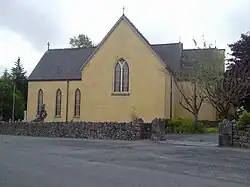Meelick, County Clare
Meelick (Irish: Míleac, meaning 'marshy land')[1] is a small village and townland in County Clare, Ireland, situated a few kilometres north of Limerick city in the Mid-West Region.
Meelick
Míleac | |
|---|---|
Village | |
 Catholic church in Meelick (built c. 1850) | |
 Meelick Location in Ireland | |
| Coordinates: 52°42′4″N 8°39′11″W | |
| Country | Ireland |
| Province | Munster |
| County | County Clare |
| Time zone | UTC+0 (WET) |
| • Summer (DST) | UTC-1 (IST (WEST)) |
Location
Historically the village of Meelick was located in an area near Stonepark townland, where the church is located.[2]
In the late 20th and early 21st century, new housing estates were developed in other areas, including at Ballycannon Heights, Elton Court, Kylevoher, Elmwood and Glen Abhainn. Other residential areas near Meelick include Cappantymore, Moneen, Stonepark (the original location of the village centre), Woodcock Hill and Ballycannon North.
History
Evidence of ancient settlement in Meelick and Stonepark townlands include a number of ringfort and enclosure sites.[3] Meelick Bridge, which spans the River Crompaun (Meelick Creek) between Clonconane and Meelick townlands, was built c. 1800.[4] The parish church at Meelick, the Catholic Church of Saint John the Baptist in Stonepark, was built c. 1850.[2]
From 1956, the area was home to 161 Hungarian refugees fleeing the Soviet repression in that country (see 1956 Hungarian Revolution). They were housed in Knockalisheen Camp, a disused army barracks dating from the Emergency.[5] In 1957, complaints and disputes between the refugees and the authorities over living conditions and enforced idleness led to a mass hunger strike. After three days, the Dáil and the Irish Red Cross negotiated an end to the strike. By the summer of 1958, most of the refugees were allowed to move to Germany and the USA while a few chose to remain in Ireland. During their stay at the camp, the 51 children attended the local St Munchin's Girls' School where they were taught both the English and Irish languages. Since the 1990s, the camp has again been used to house asylum seekers.[6]
Amenities
The village has a local GAA club and a community centre. Meelick's national (primary) school, Scoil Mhuire, had an enrollment of over 90 pupils as of 2023.[7] While the village also previously had a tavern and shop, these have since closed.
People
- Michael Brennan (Lieutenant-General), the Irish Defence Forces Chief of Staff 1931–1940, was born in Meelick.
References
- "Míleac/Meelick". Placenames Database of Ireland (logainm.ie). Retrieved 25 October 2021.
- "Catholic Church of Saint John the Baptist, Stonepark (Bunratty Lower), Meelick, Clare". buildingsofireland.ie. National Inventory of Architectural Heritage. Retrieved 12 October 2023.
- Ryan, William Gerrard (1980). "Chapter 12: Killeely Parish (Part of): Meelick Townland". A Survey of Monuments of Archaeological and Historical Interest in the Barony of Bunratty Lower, Co. Clare. UCC Press.
- "Meelick Bridge, Clonconane, Limerick". buildingsofireland.ie. National Inventory of Architectural Heritage. Retrieved 12 October 2023.
- Dáil Debate on Hungarian Refugees, 1957
- "Use of Knockalisheen in 1995". Archived from the original on 9 June 2011. Retrieved 11 January 2007.
- "Meelick National School". meelickschool.ie. Retrieved 12 October 2023.
Scoil Mhuire is a rural school in the heart of Meelick, Co. Clare [..] located just a few kilometres from the suburbs of Limerick city. We are an 7 teacher school with 96 pupils
